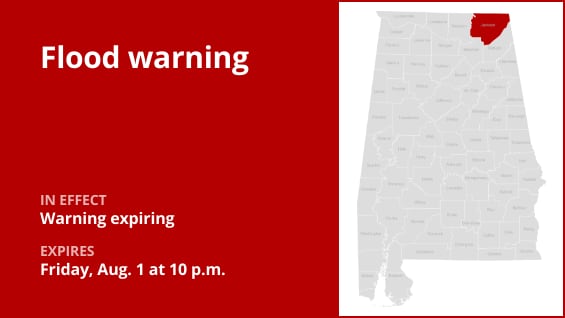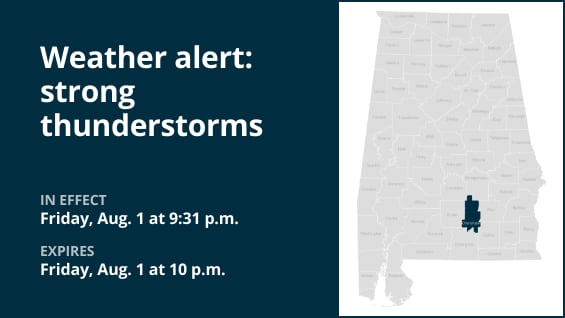Jackson County was the target of the warning.
“For a portion of Jackson County, specifically the Scottsboro, Section, Dutton, and Powell regions, the Flood Warning will end at 10 p.m. today evening. Flooding is no longer anticipated to be a hazard as flood waters recede. The National Weather Service advises people to remain paying attention to any road closures.
Your guide to weather alerts: advisories, watches, and warnings
-
Flash flood warning: Take action!
When a flash flood is approaching or already happening, a warning is sent. Get to high ground right away if you’re in a flood-prone location. A flash flood is a quick, intense flood that can form in a matter of minutes to hours. Even in places that don’t get rain right away, flash floods can happen.
-
Flood warning: Take action!
When flooding is expected or is happening, a flood warning is issued.
-
Flood advisory: Be aware:
When flooding is not predicted to become severe enough to warrant a warning, a flood advisory is issued. However, it still has the potential to be extremely inconvenient and, if careless, to result in circumstances that endanger life and/or property.
-
Flood watch: Be prepared:
When the weather is conducive to flooding, a flood watch is issued. Although it doesn’t ensure flooding will happen, it does indicate that it is a potential.
Staying safe during a flood: Recommendations from the weather service
Knowing and adhering to the weather service’s flood safety recommendations can be extremely helpful when camping in low-lying areas or in locations that are prone to flooding:
Look for higher ground.
Moving to higher ground is the first line of defense if you live in an area that floods easily or are camping in a low-lying area.
Respect evacuation directives:
Respond quickly to any evacuation orders issued by local authorities. Secure your home by locking it before you leave.
Cut off appliances and utilities:
Disconnect your appliances and utilities if you have the time. By doing this, the possibility of electrical risks during floods is decreased.
Avoid drowned places and flooding basements:
Avoid basements or rooms with electrical outlets or cords submerged in water. This lessens the chance of electrical mishaps.
Quickly leave for your safety:
Evacuate right away if you see sparks or hear popping, crackling, snapping, or buzzing noises. Avoid going into water that might be electrically charged.
Avoid the floodwaters:
Never try to cross flooding on foot. Six inches of quickly flowing water can knock you off your feet with force.
When stuck, look for higher ground:
If you find yourself caught by flowing water, move to the highest spot you can and dial 911 to reach rescue personnel.
floods is a possibility when there is a lot of rain, especially in areas that are low-lying and prone to floods. No matter how deep the water looks, it is crucial to never try to drive through it on the road. The weather service claims that most cars can be washed away by rushing water as little as 12 inches. Be knowledgeable and ready to be safe.
Navigating heavy rain: Essential safety measures for wet roads
If heavy rainfall persists or if runoff is substantial, flooding may result. Saturated soils and/or heavy rainfall can cause excessive runoff. To keep safe during periods of intense rain, heed these weather service recommendations:
Watch out for swift water flow:
Avoid parking or strolling close to drainage ditches or culverts during periods of intense rain, since the swift-moving water can be quite dangerous.
Keep your distances from other vehicles safe:
In heavy rain, the two-second rule of following distance is your friend. To guarantee safe spacing under unfavorable circumstances, increase it to four seconds.
Slow down and drive carefully:
It’s crucial to slow down on wet roads. To avoid sliding, reduce the accelerator gradually and don’t brake suddenly.
Pick your lane carefully:
Water tends to pool in the outside lanes, so stick to the central ones.
Visibility is important.
Turn on your headlights to improve visibility in severe rain. Rain-stained windows can hide cars in blind zones, so be cautious.
Be cautious on slick roads:
Because of a combination of rain, oil, and grime, roadways are at their slickest during the first 30 minutes of precipitation. Be especially careful during this time.
Stay a safe distance away from big cars:
Avoid following buses or big vehicles too closely. Their big tires produce a mist that blurs your eyesight. Additionally, be cautious when passing them; if you have to, pass swiftly and securely.
Be mindful of your wipers:
-
Overloaded wiper blades can hinder visibility. If rain severely impairs your vision, pull over and wait for conditions to improve. Seek refuge at rest areas or sheltered spots.
-
When stopping by the roadside is your only option, position your vehicle as far off the road as possible, ideally beyond guardrails. Keep your headlights on and activate emergency flashers to alert other drivers of your position.
You may greatly lower dangers and protect your health when it rains a lot by adhering to these safety precautions. To ensure a safe and sound voyage, keep yourself updated on weather conditions and follow local authorities’ instructions.
United Robots offers a service called Advance Local Weather Alerts that gathers the most recent information from the National Weather Service using machine learning.





